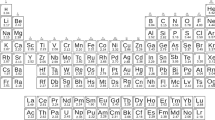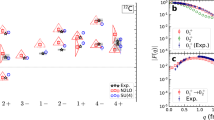Abstract
THE interesting suggestions made by Mr. W. E. Garner in NATURE for February 19 with regard to a possible explanation of the isomerism of certain organic compounds may be examined from a different, but perhaps simpler, point of view by employing the “ring electron” or “magneton” of Mr. A. L. Parson. The electron is looked upon as a circular anchor ring of negative electricity rotating about its axis at a high speed, and therefore behaving like a small magnet. In connection with atomic and molecular numbers I have directed attention elsewhere to the “rule of eight,” according to which a difference of 8 or a multiple of 8 is frequently found between the numbers of the unit electric charges associated with analogous atoms or molecules. In the theory of the “cubical atom” put forward by Prof. Gilbert N. Lewis and developed by Dr. Irving Langmuir, one of the most stable configurations for the atomic shell is that in which eight electrons are held at the corners of a cube. The single bond commonly used in graphical formulæ involves two electrons held in common by two atoms (Fig. 1); the double bond implies that four electrons are held conjointly by two atoms (Fig. 2) Or if the pair of electrons be regarded as the most stable grouping of all, it may be, as Lewis and Langmuir suggest, that the pairs of electrons held in common by two atoms are drawn closer together by the magnetic attraction between them. Dextro- and lævo-rotatory forms of a compound might then be represented as mirror images as in Fig. 3. The letters N and S in this diagram may be taken to represent the polarity of the external face of the ring electron.
This is a preview of subscription content, access via your institution
Access options
Subscribe to this journal
Receive 51 print issues and online access
$199.00 per year
only $3.90 per issue
Buy this article
- Purchase on Springer Link
- Instant access to full article PDF
Prices may be subject to local taxes which are calculated during checkout
Similar content being viewed by others
Author information
Authors and Affiliations
Rights and permissions
About this article
Cite this article
ALLEN, H. An Electronic Theory of Isomerism. Nature 105, 71–72 (1920). https://doi.org/10.1038/105071a0
Issue Date:
DOI: https://doi.org/10.1038/105071a0
Comments
By submitting a comment you agree to abide by our Terms and Community Guidelines. If you find something abusive or that does not comply with our terms or guidelines please flag it as inappropriate.



